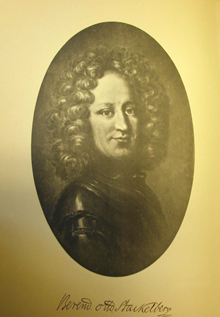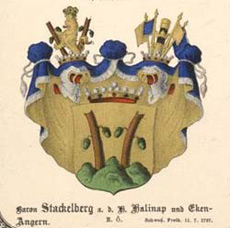|
 Baron Berndt Otto von Stackelberg (1662-1734), Field Marshal and hereditary lord of Hallinap, was born
on March 14, 1662 in Reval (Tallinn), Livonia (today Estonia). His parents were Wolter von Stackelberg and Helene von Lieven (Liwe).
Stackelberg started service as a volunteer in the guards, and advanced in ten years of service in France to the rank of captain. At the start
of the Great Northern War (1700-1721) between Sweden (King Charles XII) and the attacking forces of Russia (Tsar Peter I) for control of
the Baltic region, Baron Berndt Otto was appointed adjutant to General Otto Wellingk (1649-1708). In 1701, at the time a First Lieutenant
in the Swedish army, Stackelberg fought under Governor-General Wolmar Anton von Schlippenbach in Livonia against Russia. In the Battle
of Rauge and Kasaritz, he commanded the Swedish artillery. On March 11, 1702, Stackelberg was appointed commander of the Björneborg
regiment (Pori Brigade), founded in 1626 by King Gustav II. Adolf of Sweden during the Thirty-Year War. In 1704, Stackelberg served as
colonel under the command of the famous Swedish general Adam Ludwig Count Lewenhaupt, and fought under him in Courland and Lithuania.
Baron Berndt Otto von Stackelberg (1662-1734), Field Marshal and hereditary lord of Hallinap, was born
on March 14, 1662 in Reval (Tallinn), Livonia (today Estonia). His parents were Wolter von Stackelberg and Helene von Lieven (Liwe).
Stackelberg started service as a volunteer in the guards, and advanced in ten years of service in France to the rank of captain. At the start
of the Great Northern War (1700-1721) between Sweden (King Charles XII) and the attacking forces of Russia (Tsar Peter I) for control of
the Baltic region, Baron Berndt Otto was appointed adjutant to General Otto Wellingk (1649-1708). In 1701, at the time a First Lieutenant
in the Swedish army, Stackelberg fought under Governor-General Wolmar Anton von Schlippenbach in Livonia against Russia. In the Battle
of Rauge and Kasaritz, he commanded the Swedish artillery. On March 11, 1702, Stackelberg was appointed commander of the Björneborg
regiment (Pori Brigade), founded in 1626 by King Gustav II. Adolf of Sweden during the Thirty-Year War. In 1704, Stackelberg served as
colonel under the command of the famous Swedish general Adam Ludwig Count Lewenhaupt, and fought under him in Courland and Lithuania.
 In the Battle of Jakobstadt (Jekabpils) on July 26, 1704, Stackelberg commanded the left wing of the infantry forces, and in the Battle of
Gemauerthof on July 16, 1705, he led the infantry vanguard. In 1706 Stackelberg was promoted to Major General. In the Battle of Lesnaja
(Belarus, 1708), which was one of the decisive battles of the Great Northern War (the forerunner of Sweden’s crushing defeat at Poltava; see
below) Stackelberg, under the general command of Count Lewenhaupt, led one of the two infantry columns. In the Battle of Lesnaja, which was
fought in a severe snowstorm by troops that were outnumbered by the enemy, more than half of the Swedish soldiers were taken prisoners
of war.
In the battle of Poltava (June 28, 1709) Berndt Stackelberg, operating under the general command of General Lewenhaupt, was in
command of one of four infantry columns, and was taken prisoner by the Russians. More than 6,000 soldiers and officers were killed in the
humiliating defeat in this battle, and about 3,000 were taken prisoner. Together with other captured generals, Stackelberg was put on view
in Tsar Peter the Great’s triumphant return to Moscow. Berndt Otto Stackelberg remained in Russian captivity for almost thirteen years.
Only after the Peace of Nystad in 1721 and the end of the Great Northern War was Stackelberg released. In 1722 he was appointed
commander-in-chief of all Swedish troops stationed in Finland. In recognition of his service to his country, Stackelberg was elevated
to the barony on July 11, 1727. On the same day, he was promoted to field marshal. Baron von Stackelberg was hereditary lord of
Hallinap (Haljava) in the Baltic municipality of Järva-Jaani (in German: Sankt Johannis), located in the Järva region of Estonia
(in Estonian: Järva maakond or Järvamaa). Berndt Otto von Stackelberg was married to Baroness Margareta Elisabeth Maidel
from 1696 until his death on August 29, 1734.
In the Battle of Jakobstadt (Jekabpils) on July 26, 1704, Stackelberg commanded the left wing of the infantry forces, and in the Battle of
Gemauerthof on July 16, 1705, he led the infantry vanguard. In 1706 Stackelberg was promoted to Major General. In the Battle of Lesnaja
(Belarus, 1708), which was one of the decisive battles of the Great Northern War (the forerunner of Sweden’s crushing defeat at Poltava; see
below) Stackelberg, under the general command of Count Lewenhaupt, led one of the two infantry columns. In the Battle of Lesnaja, which was
fought in a severe snowstorm by troops that were outnumbered by the enemy, more than half of the Swedish soldiers were taken prisoners
of war.
In the battle of Poltava (June 28, 1709) Berndt Stackelberg, operating under the general command of General Lewenhaupt, was in
command of one of four infantry columns, and was taken prisoner by the Russians. More than 6,000 soldiers and officers were killed in the
humiliating defeat in this battle, and about 3,000 were taken prisoner. Together with other captured generals, Stackelberg was put on view
in Tsar Peter the Great’s triumphant return to Moscow. Berndt Otto Stackelberg remained in Russian captivity for almost thirteen years.
Only after the Peace of Nystad in 1721 and the end of the Great Northern War was Stackelberg released. In 1722 he was appointed
commander-in-chief of all Swedish troops stationed in Finland. In recognition of his service to his country, Stackelberg was elevated
to the barony on July 11, 1727. On the same day, he was promoted to field marshal. Baron von Stackelberg was hereditary lord of
Hallinap (Haljava) in the Baltic municipality of Järva-Jaani (in German: Sankt Johannis), located in the Järva region of Estonia
(in Estonian: Järva maakond or Järvamaa). Berndt Otto von Stackelberg was married to Baroness Margareta Elisabeth Maidel
from 1696 until his death on August 29, 1734.
|
 History
History
 Dates and events
Dates and events
 Persons
Persons
 Poltava
Poltava
 Sights
Sights
 Photo gallery
Photo gallery
 Maps
Maps
 Virtual Museum
Virtual Museum
 Armament
Armament
 Uniforms
Uniforms
 Coins and medals
Coins and medals
 Flags
Flags
 Paintings
Paintings
 Poltava photographs
Poltava photographs
 News
News
 About us
About us
 Acknowledgments
Acknowledgments
 Main page
Main page
 top
top ...back
...back  History
History
 Dates and events
Dates and events
 Persons
Persons
 Poltava
Poltava
 Sights
Sights
 Photo gallery
Photo gallery
 Maps
Maps
 Virtual Museum
Virtual Museum
 Armament
Armament
 Uniforms
Uniforms
 Coins and medals
Coins and medals
 Flags
Flags
 Paintings
Paintings
 Poltava photographs
Poltava photographs
 News
News
 About us
About us
 Acknowledgments
Acknowledgments
 Main page
Main page